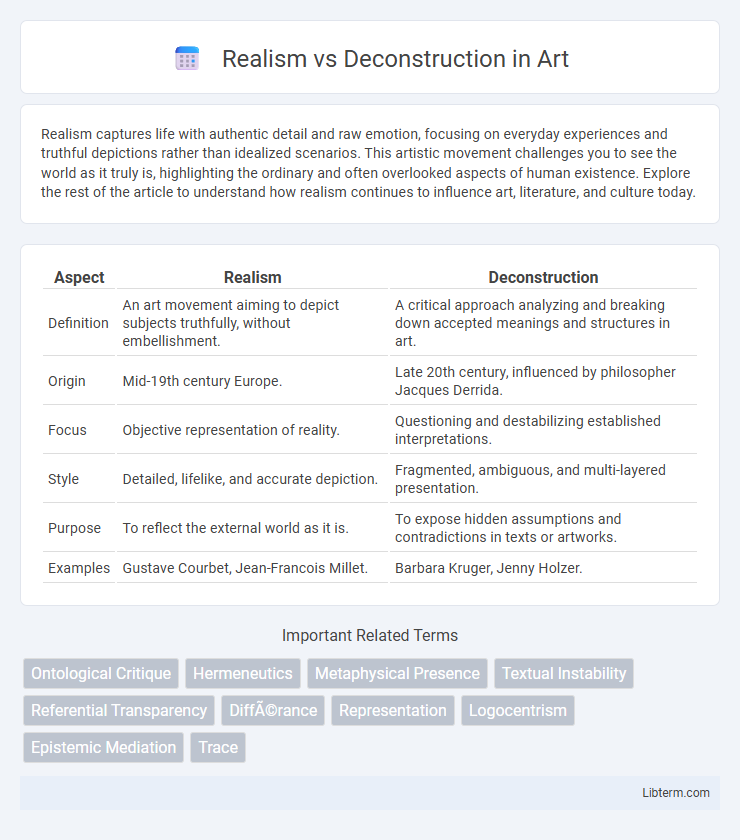Realism captures life with authentic detail and raw emotion, focusing on everyday experiences and truthful depictions rather than idealized scenarios. This artistic movement challenges you to see the world as it truly is, highlighting the ordinary and often overlooked aspects of human existence. Explore the rest of the article to understand how realism continues to influence art, literature, and culture today.
Table of Comparison
| Aspect | Realism | Deconstruction |
|---|---|---|
| Definition | An art movement aiming to depict subjects truthfully, without embellishment. | A critical approach analyzing and breaking down accepted meanings and structures in art. |
| Origin | Mid-19th century Europe. | Late 20th century, influenced by philosopher Jacques Derrida. |
| Focus | Objective representation of reality. | Questioning and destabilizing established interpretations. |
| Style | Detailed, lifelike, and accurate depiction. | Fragmented, ambiguous, and multi-layered presentation. |
| Purpose | To reflect the external world as it is. | To expose hidden assumptions and contradictions in texts or artworks. |
| Examples | Gustave Courbet, Jean-Francois Millet. | Barbara Kruger, Jenny Holzer. |
Introduction to Realism and Deconstruction
Realism emphasizes accurate representation of reality, focusing on observable facts and objective truth in literature and art. Deconstruction challenges traditional interpretations by revealing inherent contradictions and multiple meanings within texts, undermining fixed structures. These contrasting approaches shape critical analysis by prioritizing either stable representation or fluid interpretation.
Historical Origins of Realism
Realism emerged in the mid-19th century as a reaction against Romanticism, emphasizing accurate representation of everyday life and social conditions influenced by the Industrial Revolution and urbanization. Key figures like Gustave Courbet and Honore de Balzac pioneered this movement by focusing on ordinary characters and settings to depict truth and objective reality. The historical origins of Realism are deeply rooted in the socio-political changes of post-Revolutionary Europe, reflecting a shift toward scientific observation and materialism in art and literature.
The Emergence of Deconstruction
The emergence of deconstruction in the late 1960s challenged the foundational principles of realism by questioning the stability of meaning and the coherence of texts, as articulated by philosopher Jacques Derrida. Realism posits that literature and art represent an objective reality, while deconstruction destabilizes this notion by revealing inherent contradictions and ambiguities within language and interpretation. Deconstruction emphasizes the fluidity of meaning, rejecting fixed interpretations and exposing the limits of realist assumptions about truth and representation.
Key Philosophical Concepts: Realism
Realism centers on the belief that reality exists independently of human perception, emphasizing an objective world that can be known through reason and empirical observation. Key concepts include the correspondence theory of truth, where statements are true if they accurately describe the external world, and the notion of an observer-independent reality. Realism asserts the existence of mind-independent entities and properties, which contrasts with theories that deny or relativize the ontological status of the external world.
Central Tenets of Deconstruction
Deconstruction challenges the fixed meanings and hierarchical oppositions established by Realism, emphasizing the fluidity and instability of language and texts. Central tenets of Deconstruction include the idea that meaning is never fully present or complete, and that texts contain inherent contradictions and multiple interpretations. It interrogates binary oppositions, revealing how these structures privilege one concept over another, thereby destabilizing traditional realist claims of objective reality.
Comparing Core Differences
Realism emphasizes an objective reality that exists independently of perception, focusing on accurate representation and stable meaning in language and literature. Deconstruction challenges the idea of fixed meanings, arguing that texts have multiple interpretations due to inherent contradictions and the instability of language. While realism seeks coherence and truth in representation, deconstruction exposes ambiguities and the fluidity of meaning, highlighting the limitations of traditional interpretive methods.
Influence on Literature and Arts
Realism profoundly shaped literature and arts by emphasizing accurate, detailed depictions of everyday life and social conditions, driving narratives grounded in objective observation. Deconstruction challenged traditional meanings and hierarchies in texts and artworks, unveiling inherent contradictions and promoting multiple interpretations, which revolutionized critical analysis and creative expression. The interplay between Realism's objective portrayal and Deconstruction's subjective critique significantly advanced modern literary theory and postmodern art movements.
Realism vs Deconstruction in Contemporary Thought
Realism in contemporary thought emphasizes the objective existence of reality independent of perception, asserting that truth corresponds to an external world accessible through reason and empirical evidence. Deconstruction challenges this view by exposing inherent contradictions and the instability of meaning in language, suggesting that reality is mediated through texts and interpretations shaped by cultural and ideological contexts. This tension shapes debates in philosophy, literary theory, and cultural studies, influencing how knowledge, truth, and representation are understood and contested.
Critics and Debates Surrounding Both Approaches
Critics of Realism argue that its focus on objective reality often overlooks subjective experiences and cultural contexts, leading to accusations of reductionism. Deconstruction faces debates over its perceived relativism and complexity, with opponents claiming it destabilizes meaning to the point of nihilism. The ongoing discourse contrasts Realism's commitment to shared truths against Deconstruction's challenge to fixed interpretations, highlighting profound implications for literary theory and philosophy.
Future Directions in Realism and Deconstruction
Future directions in Realism emphasize integrating quantum computing and AI to model complex systems with enhanced accuracy, reflecting a commitment to objective representation of reality. In Deconstruction, emerging trends explore the intersection with digital humanities and hypertext theory, challenging traditional textual interpretations through algorithmic analysis. These advancements in both fields signal a shift toward interdisciplinary methodologies that leverage technology to deepen understanding of reality and meaning.
Realism Infographic

 libterm.com
libterm.com